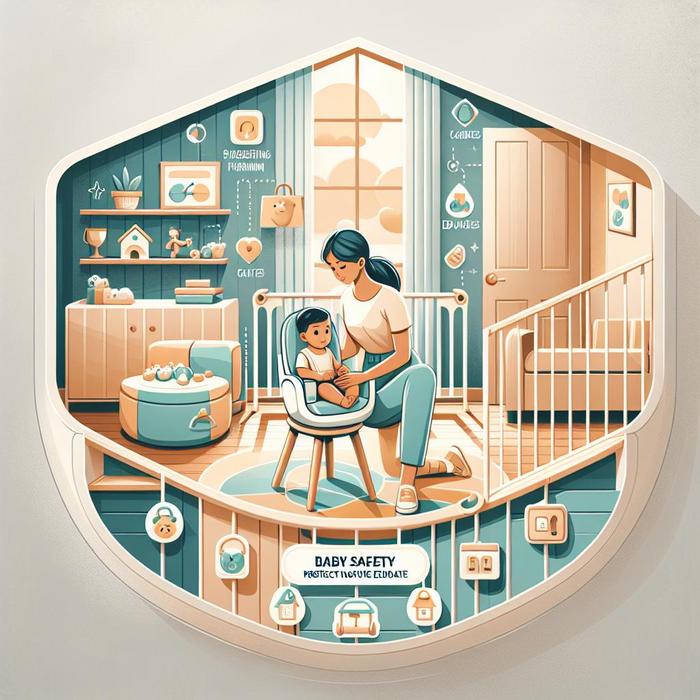Safeguarding Your Little One: A Comprehensive Guide
One of the most important aspects of parenthood is unquestionably baby safety. As parents, our primary role is to protect our children and ensure their well-being. An important area of focus is home safety, as this is where babies spend most of their time, especially in their early years.
Understanding the Risks
Kids, especially infants and toddlers, are naturally curious and adventurous. Their urge to explore their surroundings can sometimes lead them into potentially dangerous situations. Unsecured furniture, open electrical outlets, and unattended water bodies are all potential hazards within a home. It’s crucial to understand and mitigate these potential risks to ensure the protection of your baby at all times.
Safety-Proofing Your Home
When it comes to baby-proofing your home, it’s important to look at the world from your baby’s perspective. Here are some general tips:
- Secure furniture to the wall to prevent it from tipping over.
- Install safety gates at the top and bottom of any stairs.
- Keep small objects, choking hazards, and harmful chemicals out of reach.
- Use outlet covers to prevent electrical shock.
- Ensure pools, ponds, or other bodies of water are securely fenced or covered.
For a more detailed guide on home safety, you may refer to resources like the Nationwide Children’s Hospital‘s Helping Hands series or the University of Rochester Medical Center’s Infant Safety Tips.
Creating a Safe Environment for Nutrition and Play
Nutrition and play are key aspects of your baby’s development. However, they also need to be conducted safely. For example, when introducing solids, make sure all food items are appropriately sized and prepared to prevent choking. You can find excellent tips on what to feed your growing baby at www.bio-feeding.com.
During playtime, ensure that toys are age-appropriate and free from small, detachable parts that might pose a choking hazard. Also, maintain a safe space for your baby to explore, free from sharp corners and hard surfaces. For more ideas on how to boost your baby’s cognitive development safely, check out these activities.
Safety should be intrinsically woven into your daily routine with your newborn. Streamlining your routine can help minimize the risk of accidents and give you peace of mind.
Additional Resources
In addition to making your home safe for your baby, it’s also important to be aware of other potential safety concerns, such as car safety and sleep safety. The Centers for Disease Control and Prevention (CDC) and Women’s Health offer excellent resources on a broad range of safety topics.
Remember, the safety measures you put in place at home are the cornerstone of your baby’s well-being and will go a long way in ensuring their healthy development.
Practical Baby Safety Guidelines
The safety measures you implement at home should cover every aspect of your child’s lifestyle. Creating a comprehensive set of guidelines for baby safety can greatly help in ensuring your baby stays safe and healthy. Follow these practical tips:
- Never leave your baby unattended on high surfaces, even for a moment, as babies can quickly roll over or crawl over the edge.
- Prevent access to hot items, such as ovens, radiators, and hot drinks. Use rear burners on your stove, and always keep handles pointed to the back.
- Soft and plushy toys might seem harmless, but they can pose a risk of suffocation. It’s best to keep these out of their crib or sleeping area.
- Safety straps should be used on changing tables, high chairs, strollers, and other equipment every time your baby is placed in them.
- Keep blind, curtain cords, and electric cables out of your baby’s reach to prevent strangulation accidents.
If you are curious to know more about practical baby safety guidelines, Pampers have a helpful resource on baby-proofing your home.
Outdoor Safety
Safety measures don’t only apply within the confines of your home; they are equally important when your baby is outdoors. Teach your baby to stay away from the road and never leave them unattended near a pool, pond, or any other open water. Always apply sunblock and ensure they are properly dressed according to the weather. If you want further information on outdoor safety, Healthy Children provides excellent advice on maintaining a safe environment for your child
First Aid Knowledge
Even with the most extensive precautionary measures, accidents can still occur. It’s important for parents to get certified in infant and child first aid and CPR. Knowing what to do in case of a choking incident or other medical emergencies can be a lifesaver. For guidance on managing potential health emergencies, the Family Doctor website offers valuable insights.
Safe Sleep Practices
Correct sleep practices can greatly minimize risks to your baby. Always make your baby sleep on their back to reduce the risk of Sudden Infant Death Syndrome (SIDS). Also, keep their sleeping area clutter-free and well-ventilated. Pillows, plush toys, and large blankets should be kept away from their sleep space as they can pose a risk of suffocation. You can find more safe sleeping tips from the Better Health Channel.
Remember, baby safety is an on-going process. Stay updated with the latest safety guidelines and continuously assess your home and environment to make sure it’s safe for your child. By being proactive and informed, you can go to great lengths to protect your child and grant them a safe and wholesome atmosphere for growth.
.

